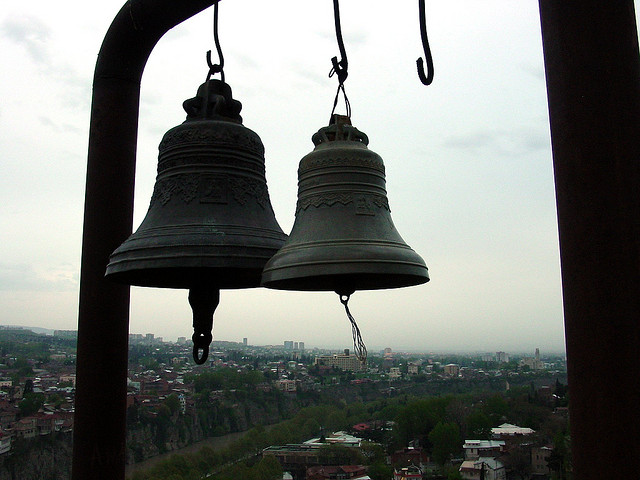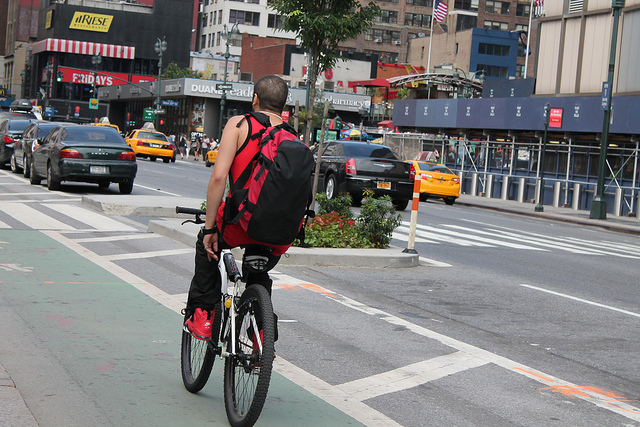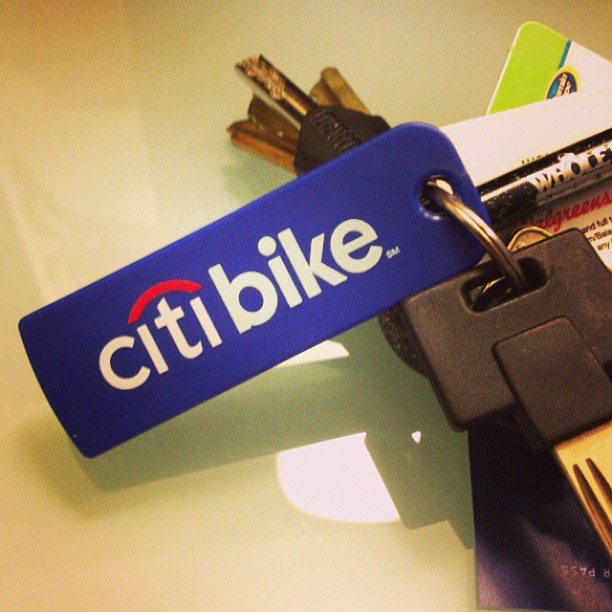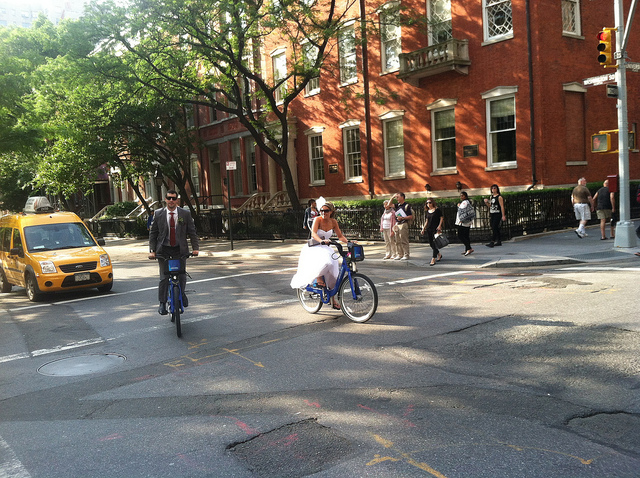It’s been about a year since the CitiBike program was first launched, and according to the statistics, CitiBikers have been taking about a million rides per month, have traveled over 10 million miles on them (which is the equivalent to over 400 trips around the earth. There was a time when one could live in NYC and enjoy relative anonymity. Of course, all of those video camera on every street corner has changed that, as has the GPS on your smart phone, but take heart: If you still feel that you want to be invisible in this town, hop on a CitiBike.
Click here to see the 10 Things You Need To Know About CitiBike
1. No one notices a CitiBiker. The pedestrian whose texting and who just walked blithely into the bike lane or into the middle of traffic doesn’t see you. Truckers don’t see you. Taxi drivers are under the assumption that they get traffic violation points removed for every cyclist they hit. Pay attention. And stay five moves ahead of everyone else on the road. Remember: you’re playing chess. They’re playing Bowling for Dullards.
2. Bells and Whistles. CitiBikes do have each have a little bell to ‘warn’ drivers and pedestrians that you’re there, should they move into your path. They’re cute, those bells. They may even be required by law. No one pays any attention to them. At all. I’ve witnessed vehicular traffic ignore fire engine, ambulance and police sirens, which are a hell of a lot louder and more persistent than what you have. So, what affect do you think that little bell has, with the possible exception of signaling to some sentimental pedestrian that an angel has just gotten its wings?
Image credit: CC by Vladimer Shioshvili
3. The new ‘bike light.’ If you’re on a bike, you’ve noticed them. They’re right next to the traffic light, and not a bad idea to pay at least some attention to them. Since the bike lanes were put in, the traffic lights – at least the ones on Broadway – seem to have been recalibrated to give drivers in the turning lanes a chance to make their turns. Across your lane, so pay attention. More than usual. If you’re cruising down the street – whether you have the light or not – always keep an eye on the drivers, and good idea to slow down a bit when you’re crossing any street or avenue. Assume that at least one of those cars is going to make a turn, right across your path. If you’re waiting for them to use their turning signals, remember: the last time most drivers used them was the day they passed their road test.
4. Designated Bike Lanes – Yes, they exist. You might have noticed those cyclist icons in certain lanes? You’re the only one who recognizes them as lanes reserved for cyclists. What drivers notice – if they spot them at all – is that the icons are flat, which they take to mean is that it’s all right to flatten a cyclist who thinks that he/she has the right of way. They’re bigger than you. They always win by default. Oh, and pedestrians are rather fond of the bike lanes, too. Great place to go to get out of sidewalk traffic and pick up that phone call. They’re oblivious to you, too. They consider those bike lanes a mere extension of the sidewalk.
Image credit: CC by Elvert Barnes
5. Wear a helmet. This is New York City. They may not be fashion statement, but they may well be life savers. The Citi Bike website offers a discount for members, as does Belle Helmets – and you can order your own artful, custom painted helmet and thus ride safely and make New York a prettier place.
6. Don’t be in such a rush. You’re on two wheels instead of two legs now, so you’ll move faster, but you’re sharing the road with vehicles, not pedestrians . Plus, the bikes are heavy and not meant to be used as practice for Le Tour de France. They’re built to survive potholes and city pavement. Respect. And always keep your eyes not only on the traffic ahead, but on the road itself as well.
7. Think twice before joining the program and do some research. Download the CitiBike app. Look at your probable starting and ending routes, and check to see how many bikes, or spaces, are available when you need them, where you need them. I used to work in midtown, and while the city supposedly has a program where they have trucks going around, delivering bikes where they’re needed most, well, let’s just say it was a good idea and worked, while they were still doing it. I haven’t seen one of those trucks in months, although occasionally I’ll see what I call a runner – a guy with a few CitiBikes strung together – moving bikes from one location to another. I did a test, and was leaving the office at 5.30 to go to an event – no bikes available within a 10-block radius. I walked to the event (a few blocks from my office), and stayed about 90 minutes, checking every 15 minutes to see if any bikes had been made available. Nope. Not a one, save for a Citi Biker who might have dropped one off, but no trucks had come around to replenished the completely depleted supply. I repeat: do your research.
We moved our office to Flatiron where there are a plethora of CitiBike stations. Warning: there are usually no available spots to dock a bike in the morning, and the only ones available in the evenings are usually red-lighted, which means that they’re out of service. I did locate one docking station where there are always spots in the mornings, and always bikes available after work. It now falls under the domain of ‘proprietary information.’
8. If you’re using the CitiBike to commute between meetings, whole different story. Bikes tend to be available during the day. They’re not only a cost-effective way to get around quickly and relatively easily, but there also tends to be less traffic on the street between rush hours. Still, always beware of cabs – and people exiting cabs – and large trucks making deliveries. And pedestrians. And street vendors, who seem to have a much easier time maneuvering their carts in the bike lanes than they do in traffic and again, they’re bigger/heavier than you are.
Image credit: CC by leesean
9. If you live north of 60th street, again, think twice before joining the program, unless you don’t mind walking before bicycling in the morning. There are no Citi Bike docks available above 60th street on either side of the park. If you work in midtown or Flat Iron, again, think twice before joining the program. There’s a good chance that there will be no place to dock your bike if you arrive to work after 9 am, and if you leave your office after 5, there will be no bikes available. Unless the weather is bad, in which case, you’ll find all the bikes you could ever hope for, but there’s probably a reason why no one else is riding them. Either they’re broken or you’re better off walking or taking public transportation, given the weather.
10. The program is a year old now – and so are the bikes. They get a lot of wear and tear on the city streets, so check them before you blithely insert your card key: make sure there are no flat tires. I fell for that one once. Didn’t check the tires. Took the bike out. Couldn’t ride it – nor could I return it from the spot whence I found it: the dock wouldn’t work and yes, I do know that there’s a trick to reinserting a bike with a flat tire into the dock. Another thing you’ll learn about the docks: if you see only a few empty spots at a docking station, chances are those particular docks are out of order. If you’re having trouble reinserting a bike with a flat front tire into the dock, note that you have to straddle the bike, lift it an inch or two off the ground and then ram it into the dock. It’ll work. Unless the dock is defective.
Welcome to Citi Bike NYC and despite the fact that I end up walking to/from work almost as often as I ride, and not by choice, I still enjoy the program (when it works) and the experience (when I can find a working bike to ride and a working dock at the end of the trip). And it’s only been a year. Wonder what it’ll be like once the program hit the Terrible Twos.
Image credit: CC by Nathan Rosenquist








